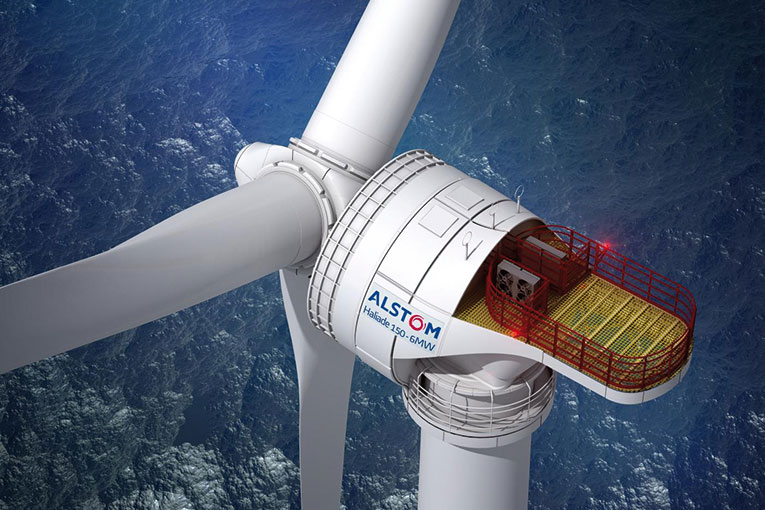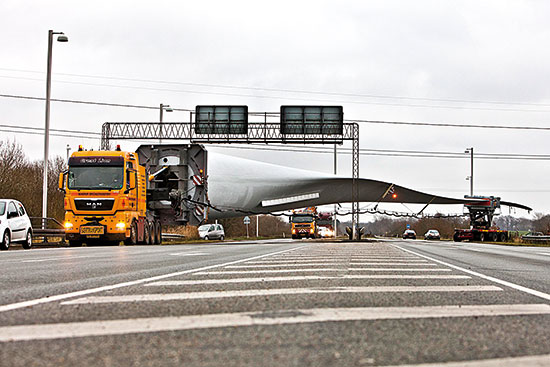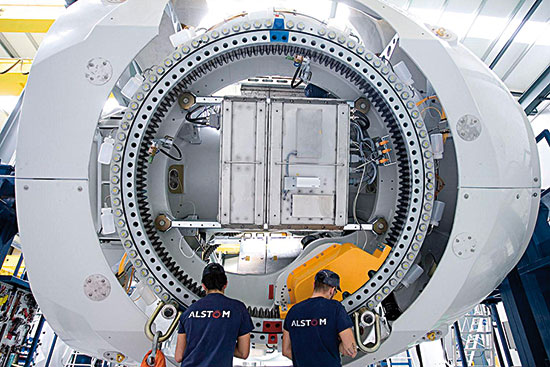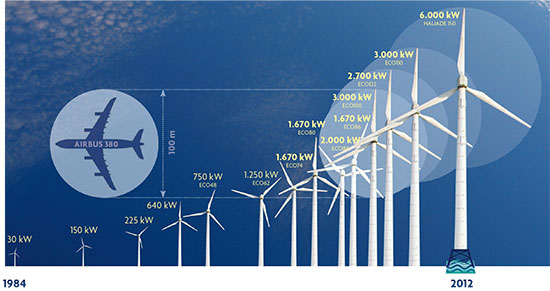 LM Windpower LM WindpowerThe huge turbine Haliade 150 generates 6 megawatts of power and measures 150 meters in diameter. These types of wind turbines are geared exclusively for marine use, where large structures can be installed without significant logistic constraints. |
||
|
In the last thirty years wind energy has been at the forefront of great research efforts although the first modern wind turbines date back to the early nineteen forties. This article provides a brief description of the origin and development of wind energy technology with respect to turbine design, resource evaluation, integration into the grid and environmental impact. The future prospects of this energy source are also discussed. |
||
|
Energy production by wind has long since ceased to be anecdotal. Far from it, wind provides a significant percentage of the electricity mix in many countries. It is the most cost effective and efficient form of renewable energy. The associated visual and environmental drawbacks are minor compared to the independent and emission-free power production it provides. Indeed, there is a long history of wind energy use. Without the wind, there would have been no sailing boats, no windmills for hauling up water or grinding grain. Although modern wind turbines may be descendants of those mills, technologically speaking they are something quite different. The stubborn resilience of the wind Designing a wind farm is an intricate and accurate task. For around the last ten years, in the Mediterranean, we are used to seeing one prevailing wind direction or two opposing predominant wind directions. This wind direction distribution has enabled us to design very compact wind farms. One day, while dealing with data from a wind-farm site in Turkey, the design team coordinator remarked in surprise: «We have two prevailing wind directions at ninety degrees, first we must double check that… it complicates our work». I answered, «You don’t have to double check; it’s straight out of the Iliad!»: Thus did the Trojans watch. But Panic, comrade of blood-stained Rout, had taken fast hold of the Achaeans and their princes were all of them in despair. As when the two winds that blow from Thrace –the north and the northwest– spring up of a sudden and rouse the fury of the main –in a moment the dark waves uprear their heads and scatter their sea-wrack in all directions– even thus troubled were the hearts of the Achaeans. Homer, The Iliad. Book ix We were analysing wind data near Troy and it just so happened I was reading The Iliad. Homer had mentioned the perpendicular wind directions three thousand years ago. This gives a wonderful image of the enduring nature of renewable energy. |
||
 Foto de la col·lecció Carl Wilcox, en possessió de Paul Gipe (Wind-works.org) Foto de la col·lecció Carl Wilcox, en possessió de Paul Gipe (Wind-works.org)The first aerogenerator of modern design, known as the Smith-Putman was erected in 1941 in Vermont (USA). Huge technical problems had to be overcome to install it. |
«Wind energy use has a long history. Without it, there would have been no sailing boats, no windmills for hauling up water or grinding grain» |
|
|
Wind technology Wind energy has been the focus of research carried out in the last thirty years by thousands of people worldwide, mainly in Europe. This research activity has focused on different areas, apart from just the practical development of conversion machinery, such as resource assessment, integration into the electric grid, forecasting, environmental and landscape integration, and so on. This technological development has taken place with the help of industry, which has been responsible for it featuring as one component of the so-called renewable energy mix. Thus, wind power accounts for 26% of electricity consumed in Denmark, 15% of that consumed in Spain and 8% of that consumed in Germany in 2010 (EWEA, 2011). Although Germany, Spain and Denmark have achieved a dominant position, it is also true that this trend is changing. While in 2002 these three countries together accounted for almost 90% of European wind-energy farms, by 2010 they only accounted for just over 35%. Indeed, by 2010 the change also became evident on the global scale: The People’s Republic of China had installed nearly twice the wind energy of Europe. Wind resource assessment The maximum power available from a moving fluid is proportional to the fluid density times the velocity cubed. This fact of physics makes the use of wind extremely sensitive to speed, and necessitates high precision information about the speed of wind. For example, to reach 10% precision in the energy production of a wind turbine system requires a wind speed assessment accuracy of 3% on site. This extreme sensitivity has led to the development of methodologies, backed by significant R&D efforts. The most accurate way to assess wind speed at a site is to place an anemometer at the exact point where you want to know the speed, for long enough to be representative of local weather effects, which is usually one year. Reliable measurements taken over a longer period, in a place close to the one being evaluated, covering a simultaneous period, are useful to correlate with the data gathered over one year, and help account for inter-annual effects. The first type of tool developed to evaluate sites was based on the use of data from taking measurements at a specific point, using a terrain model (meso/micro scale) and a simplified air-flow simulation, to establish a theoretical geostrophic wind, then by means of the same terrain model and airflow simulation, it can be transported to any other point near the terrain. The Wind Atlas Analysis and Application Program (WAsP), developed by Risø in Denmark in the early nineteen nineties, is the pioneering tool employing this methodology (DTU, 2011). Another methodology used in assessing potential wind energy is computational fluid dynamics (CFD). This is a more accurate tool, although it requires a definition of the boundary conditions of the simulation. These are difficult to establish when it comes to the atmosphere. In parallel, several quite successful large-scale weather prediction platforms have been developed, providing results that can be accessed by computer. These prediction time series are true long-term data sources applying the abovementioned methodologies. This methodology represents long-term temporal variations and provides more reliable data speeds than those obtained from local measurements. Several teams have developed such tools, for instance those by Vortex and Meteosim. |
||
|
|
||
|
The construction of wind turbines The first wind turbine connected to the grid was installed at Balaklava in 1931 and worked for ten years; however, the first modern design was the Smith-Putnam. Despite many technical problems, it was built in Vermont in 1941, staying in operation for a very short time. In 1957, in Gedser, southern Denmark, Johannes Juul, a student of the visionary Paul Lacour, installed a wind turbine to produce electricity. This was the forerunner of Danish technology, working non-stop for a decade and breaking a record in terms of size and reliability. Although these first steps were valuable demonstrations of the feasibility of wind power and its potential for producing electricity, it was not until the nineteen seventies, following the first oil crisis, when a series of machines were produced industrially for transforming wind into electric energy. Since this milestone, wind power has become an industry, and increasingly appears to be one of a number of energy sources within a range of energy solutions. Technological development, both in terms of product design and manufacturing processes, has increased turbine efficiency to the current levels. Wind turbines are machines which absorb kinetic energy from the wind with a rotor and have a system converting this energy captured from the air stream into electricity. Economic efficiency is based on producing the maximum energy and reducing, as far as possible, the amount of materials required for production. The result of improving this relationship between energy production and materials used is a reduction in the cost of energy generated. The role of wind turbines is to harvest energy from the wind, but to be viable they must fulfil certain technical requirements. Firstly, they must withstand all types of weather conditions during their operational life, including extreme wind speeds that occur in exceptional circumstances. Secondly, they also have to withstand all potential electrical conditions of the grid to which they are connected, including exceptional circumstances like short-circuiting or a lack of supply. Thirdly, turbines have to be structurally safe, which means withstanding failures in the wind turbine systems. And finally, they must maintain limited noise levels under any operating condition. These requirements involve structural stress, which is why to achieve these aims technological development has focused on a number of aspects. First, by reducing structural stress: increasingly improved intelligent systems for wind-turbine capacity and operation, incorporating processing potential to their control systems, actuators relieving wind-related stress and avoiding extreme situations. Second, improvements made to wind turbine structures make them more efficient in terms of load bearing. This includes the design of specific high-lift airfoils for wind turbines, which are bigger and more efficient. Also energy production must be optimised, improving capture by increasing the rotor surface per unit of power, employing more efficient blades and control systems, which can adapt to different operating conditions. Other areas on which research has focused include maintaining blade-tip speed and improving their shape to reduce the noise generated, increasing the size of the turbines to reduce their number and take up less space, improving wind turbine reliability and reducing maintenance requirements. Thus, in the last thirty years, reducing structural stress of turbines and the cost of the energy they produce have gone hand in hand. At the same time, the size of wind turbines has grown to the present, at which point the main limitations are logistical rather than technical. |
||
 LM Windpower LM WindpowerTransporting pieces of the turbines overland is difficult, as for this blade measuring 73.5 meters. |
«As of 2012 there is a new generation of large wind turbines, designed exclusively for marine use: about 150 m rotor diameter and power above 5 MW» |
|
|
Wind Turbines and the environment We live in a society dependent on external energy supply, based on fossil fuels. Currently society has a growing need for energy independence. This autonomy can be sought at different levels: individual, local, regional, national or European. The most important is to consider the sustainability and risks associated with a lack of autonomy. With regard to reducing energy dependence, compared to other renewable energies, wind power takes on a very important role as it is more highly developed. Like all human activities, wind power has an associated impact, but in this case –as for all renewable energies– the impact is reversible and affects the same generation that is enjoying the benefits. In the social ambit, another important effect concerns the generation of employment. In 2008, according to the Association of Renewable Energy Producers (APPA, 2010), about 40,000 people in Spain worked in the wind power sector, half directly and half indirectly. In 2009, in Europe, there were 200,000 directly employed in the wind energy sector. The impact on wildlife is the issue most often reported by the mass media, and portrayed as the greatest danger of wind energy. Currently there is greater awareness of the subject, especially regarding birds of prey and the problems wind turbines pose to them. Nowadays, more is known about their nesting sites, migratory routes and how they react to wind turbines, and this knowledge has considerably reduced these negative impacts. Perhaps the main environmental impact of wind power is the visual one. In fact, it is the issue that most restricts the development of wind energy and that generally sways opinion during the planning stages of facilities. Wind turbines are large machines, perceived as new elements in a landscape where all other anthropogenic effects have been integrated over time. The main problem in orographically complex terrain is the visibility of sites exposed to the wind. As mentioned above, energy production is extraordinarily sensitive to wind speed, which makes it virtually impossible to incorporate wind turbines into areas already destined to other industrial uses. In another vein, currently the sound level of wind turbines is quite low, and they do not produce pure tones or sounds as such. The acoustic emission of wind turbines is the aerodynamic noise of the blades and it is very difficult to discern the noise just 500 meters away. Integrating wind into the grid The Spanish power system is extremely isolated and, since the nineteen nineties, wind energy has become an important part of the system. Spain reaches days on which it is safe to say that wind contributes about 50% of the electricity generated. The last ten years have witnessed technological and organisational developments that have facilitated the integration of renewables into the Spanish electric grid (REE), reaching pioneering levels on a global scale. The REE has played a clear leadership role in this process, with the collaboration of a number of companies belonging to the spanish wind energy association (ESA). In this respect, steps have been taken to address several points. First, to ensure that wind turbines are adapted to the mode of operation of the grid, and continue to operate in exceptional circumstances of electric system failures. It also seeks to provide a reliable system to predict wind power production, which will facilitate taking the timely decisions needed to manage the power grid. Another issue under development relates to opening up the electricity transport network at numerous points, to allow the introduction of energy generated by a system and enable the most comprehensive energy balance possible. Other actions taken include strengthening transmission lines to allow energy flows modified by the installation of renewable energy, creating a system to control the introduction of renewables into the electric grid under critical circumstances and, finally, to properly manage the limited storage resources (hydraulic pump) and scattered interconnections. To the outsider, to reach great percentages of renewables integrated in the electric grid may not seem special, but it is undoubtedly a great and unique technological challenge that has been achieved though considerable collaboration and endeavour and significant R&D work. The REE is actively exporting this knowledge and leading a major European project on the integration of renewables into the grid (TWENTIES). |
||
 Altson Wind Altson WindAssembly of the nacelle of an ECO 100 wind turbine at the Alstom Wind factory in Buñuel (Navarra). Alstom Wind, the wind power unit of Alstom, has its headquarters and main R&D centre in Barcelona. Although the 3 MW wind turbine is not the largest, the size is impressive. Europe holds technological leadership in wind energy. However, both the United States and China are doing extensive research in this area. |
||
|
The sea, a new frontier Denmark and Germany are pioneers in renewable energy and have been the first to use their waters to install wind energy, also known as offshore wind power. For years now, wind turbines have been installed on foundations resting on the shallow sea bed, off the coast of these countries. The one located just a few miles off the coast of Copenhagen is perhaps the most emblematic, with a row of large wind turbines standing in a perfect curve clearly visible from the city. To date, the installation of wind farms in the marine environment has cost more than on land; however, in the North Sea, where wind speeds are very high, energy production is well above the continental inlands. On the one hand, wind turbines at sea are less visual and have fewer noise limitations; moreover, they can be larger because there are no logistic constraints. On the other hand, they have to be much more reliable, because it is impossible to reach them for repairs for relatively long time periods. Until now, offshore wind turbines were variations of those found on land but as of 2012 there is a new generation of large wind turbines, designed exclusively for marine use: about 150 m rotor diameter and power above 5 MW. The North Sea countries have launched highly ambitious programmes for the coming years, producing tens of gigawatts, paving the way for a new industrial fabric of great economic importance. These programmes include electrical interconnection infrastructure of these facilities. It should be mentioned that the only floating wind turbine is to be found off the coast of Norway, at a site 200 meters deep (HYWIND). It is an expensive project, but this is the first step. Thus turbines will leave the shallow seabed sites and start to spread over the surface of the sea. The course of R&D: know-how and future prospects In 2008, the European Wind Energy Technology Platform (TPWind) set out the main R&D agenda for future wind-energy development in a lengthy document (TPWind, 2009). TPWind encompasses more than one hundred experts, divided into different working areas (wind resources, design wind conditions and forecasting, wind turbine technology, wind energy integration, offshore deployment and operation, European research infrastructures) and periodically reviews the implementation and updating of this agenda. Europe continues to have clear technological leadership in wind energy, but both the United States and China are devoting much effort to similar research and development programmes. Harnessing the wind, heir to a great past, is very close to reaching costs that are competitive with other energy sources. Transparency in the evaluation of the costs of all energy sources, and the development of a sustainable local supply, will work to our advantage. At the same time, this will expand its potential deployment in different environments (low wind speeds, offshore, deep sites). In our diverse world, this type of renewable energy continues to grow and has bright future prospects. Indeed, the wind power era has only just begun. |
||
Bibliography
APPA, 2010. Estudio del impacto macroeconómico de las energías renovables en España. Asociación de Productores de Energías Renovables. Madrid. Available at: <http://www.appa.es/descargas/APPA2011web.pdf>.
DTU, 2011. WAsP, Wind Atlas Analysis and Application Program. Danmark Tekniske Universitet. Roskilde. Available at: <http://www.wasp.dk>.
EWEA, 2011. Wind Energy Targets for 2020 and 2030. European Wind Energy Association. Brussels.
Homer, 1996. La Ilíada. Translation by Samuel Butler. Available online at: <http://classics.mit.edu/Homer/iliad.html>.
TPWIND, 2009. Strategic Research Agenda. European Wind Energy Technology Platform. Brussels. Available at: <http://www.windplatform.eu/fileadmin/ewetp_docs/Bibliography/SRA_MDS_July_2008.pdf>.

 Changes in the size of wind turbines from 1984 to the present. By increasing their size (and power), the number of wind turbines in a wind farm can be reduced along with the total area.
Changes in the size of wind turbines from 1984 to the present. By increasing their size (and power), the number of wind turbines in a wind farm can be reduced along with the total area.



